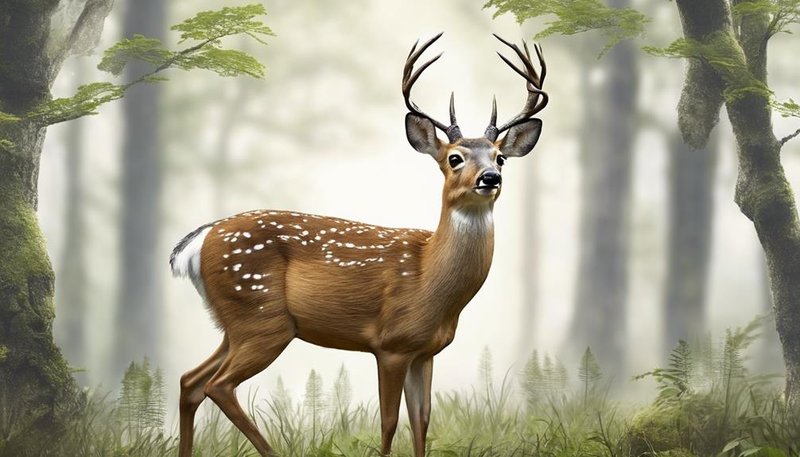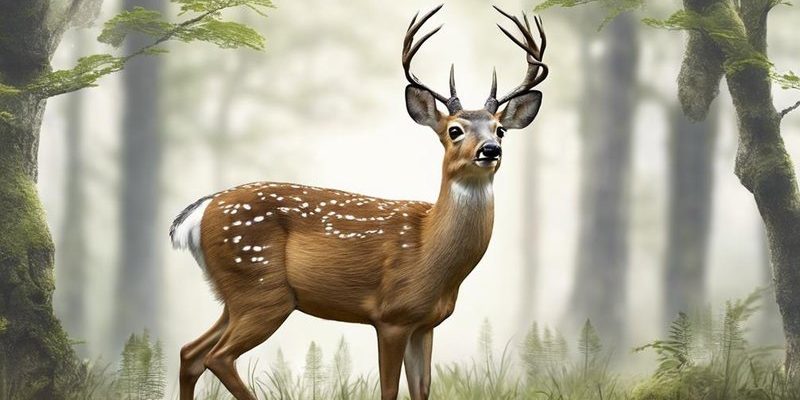
In this guide, we’ll explore ten animals that resemble deer and look at how you can tell them apart. Think of it as a wildlife trivia night, where you get to learn some fascinating facts that can impress your friends on your next outdoor adventure. So, grab your favorite beverage and let’s dive into the world of wildlife!
1. Elk
Elk are often mistaken for deer because of their similar body shape and size. However, these magnificent animals are larger, with males weighing between 600 to 1,100 pounds. Elk have long legs, a thick neck, and distinctive antlers that can reach up to four feet in length. The males sport impressive, wide antlers that they shed each year, while females typically do not have antlers at all.
One of the easiest ways to spot an elk is by their characteristic bugle call, especially during the mating season in late summer and fall. If you hear a high-pitched sound echoing through the woods, you’re likely near a herd of elk. They are social creatures, often found in groups, especially during the winter months when they seek shelter and forage for food together.
2. Moose
Moose, the largest members of the deer family, can be quite a sight to behold. Standing up to 6 feet tall at the shoulder and weighing between 800 to 1,600 pounds, these animals have a very distinct appearance. Their long legs, large bodies, and broad, palmate antlers set them apart from deer.
Moose are typically solitary creatures, preferring to roam the forests and wetlands alone—though you may see them during mating season. If you come across a moose, take a moment to observe their unique features, like the dewlap (also known as a “bell”) hanging from their throat. This gives them a distinctive look that’s quite different from the graceful profile of a deer.
3. Reindeer (Caribou)
Reindeer, also known as caribou in North America, are another close relative of deer. These animals have a unique adaptation to cold climates, with thick fur and large hooves that help them traverse snowy terrain. Interestingly, both males and females can grow antlers, making them a bit unique compared to their deer cousins.
When you see a herd of reindeer, it’s hard not to be mesmerized by their antlers, which can be quite impressive. They’re also known for their long migrations across harsh landscapes, which can be quite a sight in the fall when large groups travel together in search of food. Keep an eye out for their lighter coloration in the summer, which helps them blend into their surroundings.
4. Antelope
Antelopes are a diverse group of hoofed mammals known for their speed and graceful movements, much like deer. However, they can vary widely in size and appearance. For example, the gazelle is much smaller and more slender than a typical deer, while the larger kudu has impressive spiral horns that give it a distinct look.
You might spot antelopes in open grasslands or savannas, where they use their incredible speed to escape predators. Their adaptability to different environments helps them thrive in varied habitats, and their social behavior often results in herds that move together as a cohesive unit.
5. Sheep
While sheep may not seem like obvious relatives of deer, they share similarities in their herbivorous diets and social behaviors. Sheep are generally stockier than deer, with thick wool coats and rounded bodies. Their horns can be quite impressive, especially in breeds like the ram.
When observing sheep in the wild or on a farm, you’ll notice their tendency to stick together in flocks. This social behavior helps them stay safe from predators, just like how deer often gather in groups for protection. Plus, their bleating calls can be quite distinctive and help you identify them from afar.
6. Goat
Goats, like sheep, may not be the first animal you think of when considering deer-like creatures, but they share some common traits. With their sturdy bodies and strong legs, goats are adapted for climbing steep terrains. They have a playful nature and unique personalities that make them fun to watch.
The way goats communicate can also remind you of other herd animals. Their bleating is often accompanied by head-butting and climbing, which makes them quite entertaining. If you see a goat bounding up a rocky hill, you can’t help but think of how agile and nimble they are—similar in some ways to deer when they navigate through the woods.
7. Sika Deer
Sika deer are a smaller species of deer found primarily in East Asia, and they closely resemble their North American cousins but with a few distinct features. They have a unique spotted coat that is most pronounced in summer, giving them a beautiful, dappled look. Sika deer are also known for their distinctive calls, which can range from deep grunts to high-pitched whistles.
What sets them apart is their ability to adapt to various environments, from dense forests to open grasslands. If you happen to spot a sika deer in the wild, pay attention to their small size and short legs compared to other deer species—they’re often a bit more compact!
8. Fallow Deer
Fallow deer are another species that can confuse those familiar with the typical deer. They have a distinctively light and spotted coat, which becomes more pronounced in summer. You might spot these deer in parks and open woodlands across Europe. One clear indication of a fallow deer is the palmate shape of their antlers, which resemble a flat, hand-like structure.
These deer are social animals, often found in groups, and they have a variety of vocalizations that help them communicate. If you come across a group of fallow deer, you’ll likely notice their playful behavior and the way they graze together, much like deer do.
9. Pere David’s Deer
Pere David’s deer, also known as milu, is quite an interesting animal. Native to China, they have a unique appearance with an elongated head, broad antlers, and a body that’s somewhat larger than a standard deer. They were thought to be extinct in the wild but are now being reintroduced thanks to conservation efforts.
These deer prefer wetland habitats and are often found in swampy areas, which makes them quite distinct from the average deer foraging in forests. If you ever get the chance to see one, you’ll notice their long legs and distinctive coat, which sets them apart from other deer species.
10. Water Deer
Water deer are relatively small compared to other deer species and are known for their lack of antlers. Instead, males have prominent tusks that stick out from their mouths, giving them a unique look. They are primarily found in China and Korea and prefer wetlands, grassy marshes, and riverbanks.
These deer are excellent swimmers and are often seen foraging near water. Their shyness makes them less likely to be seen than other deer species, but if you spot one, take note of their stocky build and the way they navigate their watery habitat.
In the end, understanding the differences between these animals can deepen your appreciation for wildlife. From the majestic elk to the quirky water deer, each has its own charm and role in the ecosystem. The next time you’re out in nature, you’ll have a better chance of recognizing these creatures and enjoying the beauty of the diversity around you. So, keep your eyes peeled and your camera ready—nature is full of surprises!

